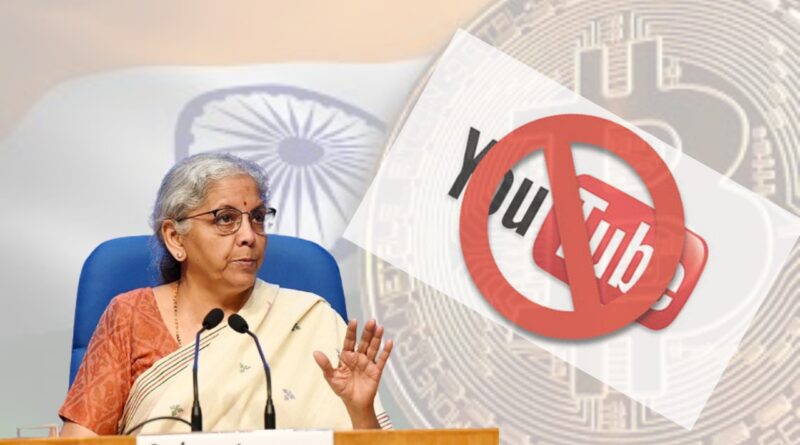Why the Indian Government May Be Behind Crypto YouTube Video Bans
Uncover why the Indian government’s anti-crypto policies, including 30% tax and AML rules, may drive YouTube’s 2025 crackdown on crypto videos, impacting creators and investors.
Introduction
In 2025, Indian cryptocurrency content creators are facing an unprecedented wave of video takedowns and channel terminations on YouTube, raising concerns about censorship driven by the Indian government’s stringent regulatory stance on cryptocurrencies. Posts on X, such as those by @Maddy_Web3, @CryptooAdy, @CryptooIndia, @simplykashifsuggest that YouTube’s actions may be influenced by government pressure, potentially as a miscalculated effort to curb crypto-related activities.
This article explores the Indian government’s historical and current policies on cryptocurrencies, the reasons behind its anti-crypto stance, the link to YouTube’s content moderation, and actionable steps for crypto YouTube creators to protect their channels.
The Indian Government’s Historical Stance on Cryptocurrencies
India’s relationship with cryptocurrencies has been tumultuous, marked by skepticism and regulatory clampdowns. The journey began in 2013, when the Reserve Bank of India (RBI) issued its first warning about the risks of cryptocurrencies, citing concerns over volatility, fraud, and lack of legal tender status. This set the tone for a cautious approach. In April 2018, the RBI escalated its stance by imposing a banking ban, prohibiting financial institutions from providing services to crypto-related businesses, effectively stifling the industry. This move was driven by fears of cryptocurrencies facilitating money laundering, tax evasion, and financial instability. However, in March 2020, the Supreme Court of India overturned the RBI’s ban, citing it as unconstitutional, allowing crypto exchanges to resume operations and sparking a resurgence in crypto trading.
Despite this victory, the government’s apprehension persisted. In 2021, the proposed Cryptocurrency and Regulation of Official Digital Currency Bill aimed to ban all private cryptocurrencies while promoting a central bank digital currency (CBDC) issued by the RBI. Although the bill has not been passed as of 2025, it signaled the government’s intent to tightly control the crypto ecosystem, allowing exceptions only for technologies like blockchain that align with state interests.
Current Crypto Policies in India (2025)
As of June 2025, cryptocurrencies like Bitcoin and Ethereum remain legal to trade and hold in India but are not recognized as legal tender. The government has introduced several measures to regulate the sector:
- Taxation Regime (2022): The Union Budget 2022 classified cryptocurrencies as Virtual Digital Assets (VDAs) under Section 2(47A) of the Income Tax Act, imposing a 30% tax on crypto gains and a 1% Tax Deducted at Source (TDS) on transactions exceeding ₹50,000 annually. These high taxes were designed to discourage speculative trading and monitor transactions, but they have been criticized for stifling innovation and pushing investors to unregulated offshore platforms.
- Anti-Money Laundering (AML) Regulations (2023): In March 2023, crypto exchanges and service providers were brought under the Prevention of Money Laundering Act (PMLA), mandating strict Know Your Customer (KYC) requirements and suspicious transaction reporting to the Financial Intelligence Unit (FIU). This move aimed to curb illicit activities but increased compliance burdens for crypto businesses.
- Enforcement Actions: In December 2023, the FIU issued show-cause notices to nine offshore crypto exchanges, including Binance, for non-compliance with local regulations. Binance was fined ₹188.2 million ($2.25 million) in June 2024, highlighting the government’s aggressive enforcement.
- Upcoming Policy Paper (June 2025): The Ministry of Finance is set to release a comprehensive discussion paper on crypto regulations in June 2025, seeking stakeholder input to align India’s policies with global standards set by bodies like the Financial Stability Board (FSB) and International Monetary Fund (IMF). This paper aims to address financial stability, investor protection, and illicit activity concerns, but its outcome remains uncertain.
Why the Indian Government Has Been Anti-Crypto
The Indian government’s anti-crypto stance stems from several concerns:
- Financial Stability Risks: The RBI has consistently argued that cryptocurrencies pose risks to macroeconomic and financial stability due to their volatility and potential to undermine monetary policy. The decentralized nature of cryptocurrencies reduces the RBI’s control over the money supply, a critical tool for managing the Indian rupee.
- Illicit Activities: Authorities, including the FIU and Enforcement Directorate, worry that cryptocurrencies facilitate money laundering, terror financing, and tax evasion. High-profile incidents, such as the $230 million WazirX hack in 2024, have reinforced these concerns.
- Consumer Protection: The government cites rampant scams, fraud, and Ponzi schemes in the crypto space as justification for stringent oversight. SEBI and the Consumer Protection Act (2019) emphasize protecting investors from misleading financial advice, which extends to online content.
- Global Influence and Caution: India’s policies are influenced by global trends, such as China’s crypto bans in 2021 and evolving regulations in the U.S. and Europe. The RBI’s preference for a CBDC over private cryptocurrencies reflects a desire to maintain state control over digital finance.
- Tax Revenue and Compliance: The 30% tax and 1% TDS, along with proposed penalties for undeclared crypto gains (up to 70% for up to 48 months), indicate the government’s focus on capturing revenue and ensuring compliance. Unregulated crypto trading is seen as a threat to tax collection.
Link Between Government Policies and YouTube Deletions
Now lets discuss the main point here. The Indian government’s stringent crypto policies likely contribute to YouTube’s aggressive moderation of crypto content in several ways:
- Regulatory Pressure on Platforms: India’s history of internet censorship, with over 450 regional internet shutdowns since 2014 and frequent takedown requests for social media content, suggests that YouTube may be acting preemptively to align with government expectations. The government’s influence on platforms is evident in cases like the 2020 legal action against comedian Kunal Kamra for critical tweets, indicating a broader trend of controlling online narratives.
- SEBI’s Crackdown on Financial Content: In 2024, SEBI removed over 15,000 pieces of unauthorized financial content, including YouTube videos, for promoting unregulated financial products. Crypto content, often perceived as speculative or misleading, may be caught in this net, especially if it lacks clear disclaimers or promotes unrealistic gains.
- YouTube’s Algorithmic Overreach: YouTube’s automated moderation tools, which flag 96% of policy-violating content, may misinterpret educational crypto videos as scams or harmful content, particularly if they mention high returns or unregulated tokens. This aligns with posts on X, like @Maddy_Web3’s, which claim YouTube is “silently targeting” Indian crypto creators, possibly due to algorithmic errors amplified by government scrutiny.
- Mass Reporting and Competitor Influence: X posts speculate that coordinated mass reporting by competitors or anti-crypto groups could trigger YouTube’s algorithms, leading to strikes and deletions. The government’s anti-crypto rhetoric may embolden such campaigns, indirectly pressuring platforms to act.
- Global Precedents: YouTube’s global crypto content purges, such as in 2019, were attributed to “harmful or dangerous content” policies. India’s regulatory environment, combined with SEBI’s focus on investor protection, likely amplifies these global policies locally, leading to disproportionate enforcement against Indian creators.
Implications of Over-Censorship
The government’s heavy-handed approach and YouTube’s subsequent actions have significant consequences:
- Stifling Education: Removing legitimate crypto content reduces access to educational resources, leaving investors vulnerable to scams on unregulated platforms, as noted by @Maddy_Web3.
- Economic Impact: With over 15 million crypto traders in India, censorship could push activity to offshore exchanges, reducing tax revenue and regulatory oversight.
- Innovation Suppression: Over-censorship risks stifling India’s blockchain and Web3 ecosystem, despite initiatives like Telangana’s Web3 Sandbox.
- Creator Livelihoods: Channel terminations threaten the income of creators who rely on YouTube for monetization, as seen with influencers like @Crypto794Investot and @CryptoKingKeyur.
Conclusion
The Indian government’s anti-crypto stance, driven by concerns over financial stability, illicit activities, and consumer protection, has created a challenging environment for crypto content creators. Policies like the 30% tax, 1% TDS, and PMLA compliance requirements reflect a broader effort to control the crypto ecosystem, likely influencing YouTube’s aggressive moderation of crypto content in India. While this over-censorship risks stifling education and innovation, creators can protect their channels by focusing on compliant, educational content, diversifying platforms, and engaging their communities.
By staying informed about the upcoming 2025 crypto policy paper and aligning with regulatory expectations, creators can navigate this landscape while advocating for a balanced approach to crypto regulation in India.
Disclaimer: This article is for informational purposes only and does not constitute legal or financial advice. Always conduct your own research and consult professionals before acting on any recommendations.




